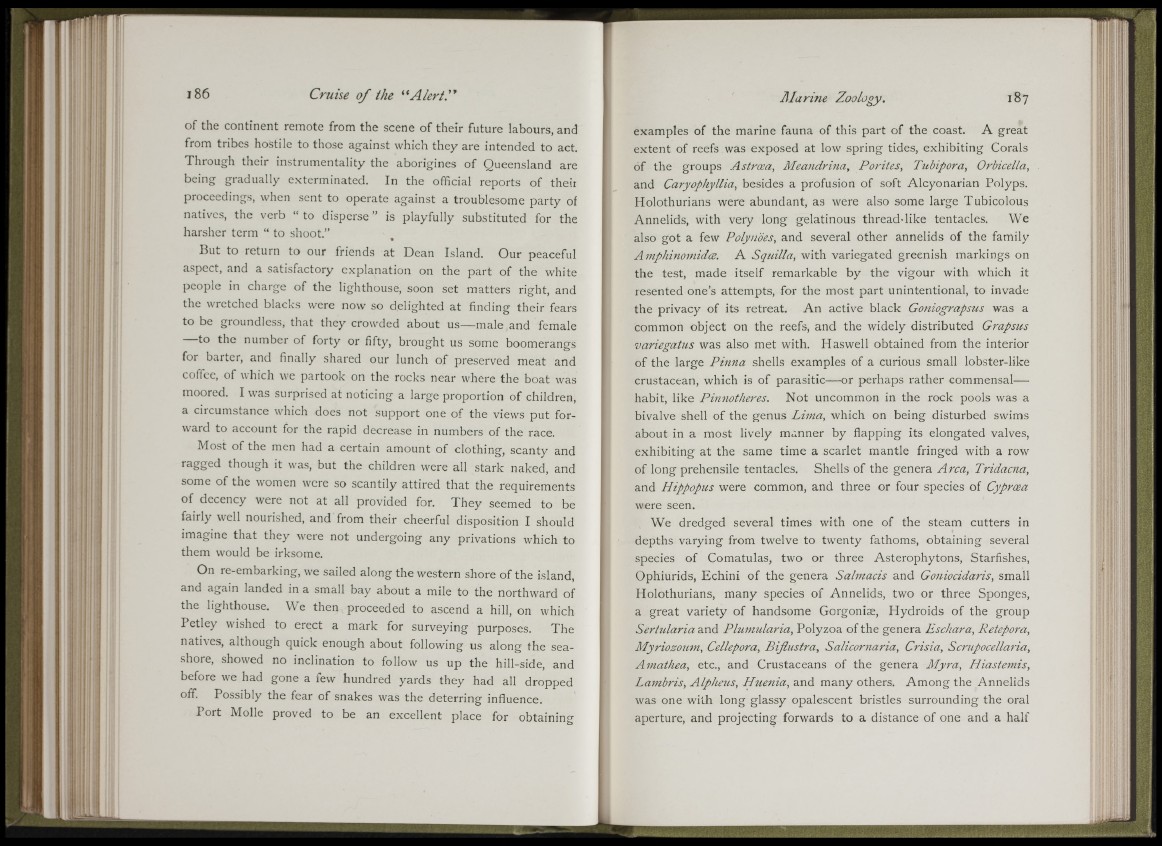
m
i
1 86 Cruise o f the “ Alert.”
of the continent remote from the scene of their future labours, and
from tribes hostile to those against which they are intended to act.
Through their instrumentality the aborigines of Queensland are
being gradually exterminated. In the official reports of their
proceedings, when sent to operate against a troublesome party of
natives, the verb “ to disperse ” is playfully substituted for the
harsher term “ to shoot.”
But to return to our friends at Dean Island. Our peaceful
aspect, and a satisfactory explanation on the part of the white
people in charge of the lighthouse, soon set matters right, and
the wretched blacks were now so delighted at finding their fears
to be groundless, that they crowded about us— male and female
to the number of forty or fifty, brought us some boomerangs
for barter, and finally shared our lunch of preserved meat and
coffee, of which we partook on the rocks near where the boat was
moored. I was surprised at noticing a large proportion of children,
a circumstance which does not support one of the views put forward
to account for the rapid decrease in numbers of the race.
Most of the men had a certain amount of clothing, scanty and
ragged though it wa.s, but the children were all stark naked, and
some of the women were so scantily attired that the requirements
of decency were not at all provided for. They seemed to be
fairly well nourished, and from their cheerful disposition I should
imagine that they were not undergoing any privations which to
them would be irksome.
On re-embarking, we sailed along the western shore of the island,
and again landed in a small bay about a mile to the northward of
the lighthouse. We then proceeded to ascend a hill, on which
Petley wished to erect a mark for surveying purposes. The
natives, although quick enough about following us along the seashore,
showed no inclination to follow us up the hill-side, and
before we had gone a few hundred yards they had all dropped
off. Possibly the fear of snakes was the deterring influence.
Port Molle proved to be an excellent place for obtaining
Marine Zoology. 187
examples of the marine fauna of this part of the coast. A great
extent of reefs was exposed at low spring tides, exhibiting Corals
of the groups Astroea, Meandrina, Porites, Tubipora, Orbicella,
and Caryophyllia, besides a profusion of soft Alcyonarian Polyps.
Holothurians were abundant, as were also some large Tubicolous
Annelids, with very long gelatinous thread-like tentacles. We
also got a few Polynoes, and several other annelids of the family
Amphinomidæ. A Squilla, with variegated greenish markings on
the test, made itself remarkable by the vigour with which it
resented one’s attempts, for the most part unintentional, to invade
the privacy of its retreat. An active black Goniograpsus was a
common object on the reefs, and the widely distributed Grapsus
variegatus was also met with. Haswell obtained from the interior
of the large Pinna shells examples of a curious small lobster-like
crustacean, which is of parasitic— or perhaps rather commensal—
habit, like Pinnotheres. Not uncommon in the rock pools was a
bivalve shell of the genus Lima, which on being disturbed swims
about in a most lively manner by flapping its elongated valves,
exhibiting at the same time a scarlet mantle fringed with a row
of long prehensile tentacles. Shells of the genera Area, Tridacna,
and Hippopus were common, and three or four species of Cyproea
were seen.
We dredged several times with one of the steam cutters in
depths varying from twelve to twenty fathoms, obtaining several
species of Comatulas, two or three Asterophytons, Starfishes,
Ophiurids, Echini of the genera Salmacis and Goniocidaris, small
Holothurians, many species of Annelids, two or three Sponges,
a great variety of handsome Gorgoniæ, Hydroids of the group
Sertularia and Plunmlaria, Polyzoa of the genera Eschara, Retepora,
Myriozonm, Cellepora, Biflustra, Salicornaria, Crisia, Scrupocellaria,
Amathea, etc., and Crustaceans of the genera Myra, Hiastemis,
Lambris, Alpheus, Eliienia, and many others. Among the Annelids
was one with long glassy opalescent bristles surrounding the oral
aperture, and projecting forwards to a distance of one and a half
m]
■m:
y.Xir
/î '
H i
J:li'■
: . 1 . Ì 1.,